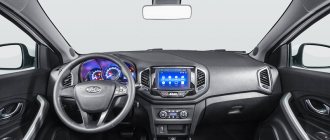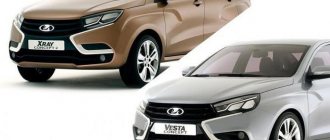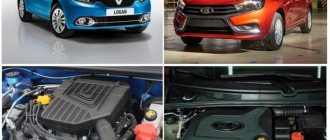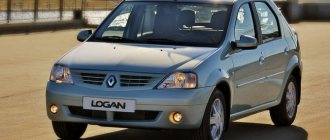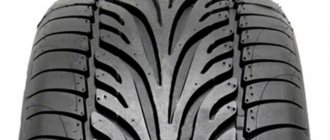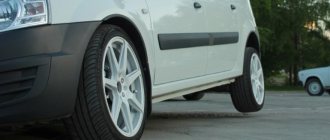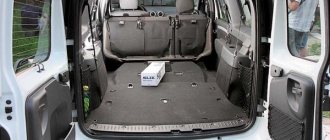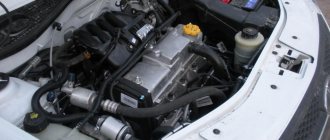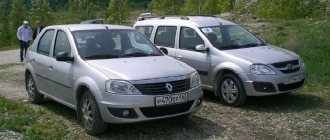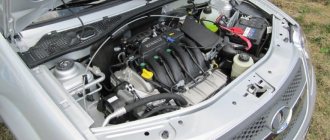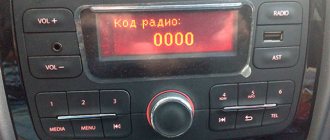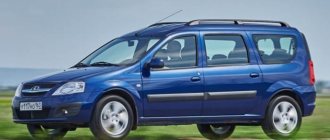Dirt is not their friend
And what exercises are “Crosscrossers” ready to perform off-road?
We answer: only the most primitive ones, since both Kalina Cross and Largus Cross are ordinary single-wheel drive station wagons that only “stood on their tiptoes.” At the factory, we slightly changed the “geometry” of the chassis, installed larger wheels, and it’s done: under the bottom of the Largus we measured 21 cm of ground clearance, while for the Kalina this figure was 18 cm. Just jump along the gullies on the Kalina. much more interesting. The base is shorter, the overhangs are smaller, and the 8-valve 1.6-liter engine (87 hp) is good off the asphalt. You can attack obstacles thoughtfully and forcefully: the short main gear (3.9 instead of the standard 3.7) and sufficient torque at low speeds allow you to drive on light off-road conditions sedately and measuredly - you don’t burn out the clutch, you don’t overclock the engine. You just go.
“Largus” requires a completely different treatment: swords drawn and driven at breakneck speed! Otherwise you'll get stuck. Yes, the main gear here is all 4.2, but the “superior” nature of the 16-valve engine (105 hp) could not be adjusted by selecting gear ratios: at low speeds the engine tends to stall, but if you give it gas, the wheels instantly bury themselves in wet soil. An alternative motor is needed. And he will! But after a year or two: it is known that VAZ is now working on a 1.8-liter (132 hp) version of the station wagon, but they do not name the date of appearance of such a car.
On a hard surface, “Larchika” is, of course, more pleasant. Short gears and lively reactions make you believe that the heavy car is quite dynamic for hectic city life. The key word is “urban”. Outside populated areas, when the speedometer needle crosses o, the euphoria ends, because the revs are under 3500, the engine roars, and there are no more gears—sixth is catastrophically missing. The “shortened” transmission (which is also not distinguished by the clarity of shifts) also does not contribute to fuel economy.
Will the “viburnum-berry” be able to catch up with its nimble opponent? Due to more modest characteristics - 87 hp. vs. 105 and 140 N∙m vs. 148 - the dynamics of the “ladushka” are calmer, the responses are more thoughtful, so the orange station wagon loses at traffic light starts. But on the highway there is parity: again thanks to the sinewy thrust of the eight-valve engine. It’s not for nothing that Datsun engineers, who built mi-DO from Kalina, consider this unit to be the most balanced VAZ engine.
It’s a pity, but we were able to get the 16-valve Kalina Cross only after we handed over the 8-valve one. However, we will announce the conclusions of the correspondence comparison. In the city there is such a “barn” - fire and hurricane! The claimed 10.8 seconds to 100 km/h is easy to believe. But when driving on a country road, the 106-horsepower Lada suffers from a lack of low-end torque and therefore resembles a Largus. Therefore, when choosing a power unit for Kalina, remember: 106 hp. — for the city, 87 hp. - for the village.
However, as we know, on our roads, the first one to get there is not the car with the most powerful engines, but the one with the most powerful engines. where the suspension is stronger. This means that the “elevated” station wagons finish at the same time. Quasi-crossovers fly over the shattered asphalt without understanding the road, deftly swallowing bumps of any caliber. With one amendment: the original Kalina and Largus, without the Cross prefixes, completely dead sections will go even smoother - for both “crosses” the increase in ground clearance resulted in a decrease in the suspension rebound travel. Handling was not affected - it remained sluggish as it was.
"Kalina" is a good option for a young family. Because it's inexpensive and bright. "Largus" is an ideal car for a summer resident or father of many children. Because it's big and roomy. And it’s impossible to choose the best car from these two - they are both too different, although they are equally abundantly endowed with a considerable number of shortcomings (also different). Who is the best all-terrain vehicle? Both Togliatti “cross” vehicles are equally powerless off-road - at a minimum, they lack inter-wheel locks.
But is it then worth buying such “quasi-crossovers” at all? Most likely, yes: extra centimeters of ground clearance and a body kit made of unpainted plastic are useful things. In addition, the “sneakers from Togliatti” are shod with quite decent tires (the Kalina has Pirelli, the Largus has Continental) and their interior decoration improves the mood. And most importantly, VAZ drivers charge inexpensively for increasing the ground clearance - the difference between simple station wagons and crossovers is less than 30 thousand rubles.
Engines
Lada Largus or Renault Logan, which is better?
As for motors, the differences with them are significant. The models are similar in that their engine capacity has few cubic meters. Plus it's about the same. The difference is only a couple of cubic centimeters. Approximately, the volume is 1.6 liters, which is not that much, but taking into account the budget, it is quite expected and acceptable.
But in terms of power, the Duster is significantly superior to its competitor, because it is capable of demonstrating all 114 horsepower at the peak of its capabilities. Is this too much? No, and again no, and to be convinced of this, just look at the characteristics of the top representatives of the SUV or station wagon class, where even 300 horsepower is by no means the limit.
That is why the fact that the Lada has only 87 horsepower makes the Duster much more interesting for those who are interested in dynamic performance rather than some other features of the car. In this case, the difference of almost 30 horsepower will play a significant role in how these two vehicles perform on the road.
As for the torque, the Renault Duster has 156 Newtons per meter at 4000 rpm, while the Lada has only 140 Newtons per meter at 3800 rpm, which, however, is also not bad. It turns out that the engines of the cars, although they are not too different, the Duster version is still more suitable for off-road driving, while the Largus Cross is unlikely to cope with a really serious cross-country race.
Comparison with closest competitors
- Kia Sportage or Renault Duster
- Nissan Qashqai or Renault Duster
- Renault Duster or Lada X-RAY
- Renault Duster or Niva Chevrolet
- Lifan X60 or Renault Duster
- Renault Duster or Renault Sandero Stepway?
- Renault Duster or UAZ Patriot?
- Mitsubishi ASX or Renault Duster
- Renault Duster or Skoda Yeti
- Chery Tiggo or Renault Duster?
What kind of oil is better to fill in the engine 16 valves Lada Largus
It seems like the Lada Largus is nothing like the reviews, but after Kalina I have confidence in Ladas somehow…. it's called paranoia) So Duster.
You know, I hear and read very bad reviews of the French. Renault, Peugeot - that's the only way they break down. Imported cars are more reliable. Renault, of course, inspires more trust. As a girl, design really excites me.
I don’t understand why ours still can’t create normal cars, like the Europeans, so that we can really compare.
I agree with you, Alexey. Of course Duster. Our cars are bought only by poverty and the village with loans, because they are not given money for a normal car. This is how our auto industry still rests #128578;
If you want to support a domestic manufacturer, then fine, otherwise they are about the same.
For the most part, VAZ manufactures its cars based on this particular French comrade. I have sufficient operating experience as a product from VAZ and Renault. The cars are in completely different class categories. If you choose between Largus and Duster, then definitely Duster. Comfort, design, quality, horsepower - these are only a small part of how the Duster is superior to Largus
Dirt is not their friend
Comparison of Renault Duster engine resources
And what exercises are “Crosscrossers” ready to perform off-road? We answer: only the most primitive ones, since both Kalina Cross and Largus Cross are ordinary single-wheel drive station wagons that only “stood on their tiptoes.” At the factory, we slightly changed the “geometry” of the chassis, installed larger wheels, and we were done: under the bottom of the Largus we measured 21 cm of ground clearance, while for the Kalina this figure was 18 cm.
But it’s much more interesting to ride along the gullies on the Kalina. The base is shorter, the overhangs are smaller, and the 8-valve 1.6-liter engine (87 hp) is good off the asphalt. You can attack obstacles thoughtfully and forcefully: the short main gear (3.9 instead of the standard 3.7) and sufficient torque at low speeds allow you to drive on light off-road conditions sedately and measuredly - you don’t burn out the clutch, you don’t overclock the engine. You just go.
“Largus” requires a completely different treatment: swords drawn and driven at breakneck speed! Otherwise you'll get stuck. Yes, the main gear here is all 4.2, but the “superior” nature of the 16-valve engine (105 hp) could not be adjusted by selecting gear ratios: at low speeds the engine tends to stall, but if you give it gas, the wheels instantly bury themselves in wet soil. An alternative motor is needed. And he will! But after a year or two: it is known that VAZ is now working on a 1.8-liter (132 hp) version of the station wagon, but they do not name the date of appearance of such a car.
On a hard surface, “Larchika” is, of course, more pleasant. Short gears and lively reactions make you believe that the heavy car is quite dynamic for hectic city life. The key word is “urban”. Outside populated areas, when the speedometer needle crosses o, the euphoria ends, because the revs are under 3500, the engine roars, and there are no more gears—sixth is catastrophically missing. The “shortened” transmission (which is also not distinguished by the clarity of shifts) also does not contribute to fuel economy.
Will the “viburnum-berry” be able to catch up with its nimble opponent? Due to more modest characteristics - 87 hp. vs. 105 and 140 N∙m vs. 148 - the dynamics of the “ladushka” are calmer, the responses are more thoughtful, so the orange station wagon loses at traffic light starts. But on the highway there is parity: again thanks to the sinewy thrust of the eight-valve engine. It’s not for nothing that Datsun engineers, who built mi-DO from Kalina, consider this unit to be the most balanced VAZ engine.
It’s a pity, but we were able to get the 16-valve Kalina Cross only after we handed over the 8-valve one. However, we will announce the conclusions of the correspondence comparison. In the city there is such a “barn” - fire and hurricane! The claimed 10.8 seconds to 100 km/h is easy to believe. But when driving on a country road, the 106-horsepower Lada suffers from a lack of low-end torque and therefore resembles a Largus. Therefore, when choosing a power unit for Kalina, remember: 106 hp. — for the city, 87 hp. - for the village.
However, as we know, on our roads, the first one to get there is not the car with the most powerful engines, but the one with the most powerful engines. where the suspension is stronger. This means that the “elevated” station wagons finish at the same time. Quasi-crossovers fly over the shattered asphalt without understanding the road, deftly swallowing bumps of any caliber. With one amendment: the original Kalina and Largus, without the Cross prefixes, completely dead sections will go even smoother - for both “crosses” the increase in ground clearance resulted in a decrease in the suspension rebound travel. Handling was not affected - it remained sluggish as it was.
"Kalina" is a good option for a young family. Because it's inexpensive and bright. "Largus" is an ideal car for a summer resident or father of many children. Because it's big and roomy. And it’s impossible to choose the best car from these two - they are both too different, although they are equally abundantly endowed with a considerable number of shortcomings (also different). Who is the best all-terrain vehicle? Both Togliatti “cross” vehicles are equally powerless off-road - at a minimum, they lack inter-wheel locks.
But is it then worth buying such “quasi-crossovers” at all? Most likely, yes: extra centimeters of ground clearance and a body kit made of unpainted plastic are useful things. In addition, the “sneakers from Togliatti” are shod with quite decent tires (the Kalina has Pirelli, the Largus has Continental) and their interior decoration improves the mood. And most importantly, VAZ drivers charge inexpensively for increasing the ground clearance - the difference between simple station wagons and crossovers is less than 30 thousand rubles.
Vehicle Specifications
Which is better VAZ 2112 or VAZ 2114: comparison of models
In this regard, all the cars turned out to be different from each other, so there is something to compare here.
Review of Largus and Duster
The power plants of the two cars have the same volume, but there are differences between them. Both cars are budget, so the volume of 1.6 liters (with a slight difference of a few cubic centimeters) is standard. Duster wins due to its greater power; it has a maximum of 114 horsepower. These horses are clearly not enough for a full-fledged SUV, especially considering that the latter have a power of 300 hp. With. and higher is a common indicator, and engine volumes are much larger.
The Lada Largusa has an engine power of only 87 hp. s., but on the road the difference of 30 horses is practically not felt, given the different weights of the cars, and the acceleration is approximately the same. The torque of Duster is 156 N/m, and that of Largus is 140 N/m. From this we can conclude that the engines have many similarities, but Duster’s power unit is still adapted for off-road driving
Even taking into account the version of the Largus Cross with increased ground clearance, it should not be regarded as an off-road conqueror
The transmission of two cars is manual, five-speed. However, Duster has clearer manual transmission shifts. In addition, the “French” boasts a full-fledged 5-band automatic transmission.
Logan or Largus
Both have front-wheel drive with MacPherson strut suspension. Logan has a gasoline engine with a capacity of 73 horses. And the station wagon version additionally has an 84-liter diesel engine. With. The Lada does not have a diesel engine and is not expected to have one, but it has two gasoline engines. In addition to the above, there is also a more powerful 102 hp power unit. With.
Car appearance
It would be more correct to start the comparison with a station wagon from Russia, because this particular car is positioned as an alternative to the “French”.
Exterior and characteristics of Lada Largus and Renault Logan
Initially, the Russian car was modified to take into account the harsh conditions of our winters. In addition, the manufacturer applied special treatment to prevent corrosion of individual elements. The anti-corrosion layer is mainly used on the underbody and wheel arches. The thickness of the coating is approximately 5 mm thicker in comparison with Logan. The anticorrosive layer contains components that increase resistance to sudden temperature changes and the negative effects of various chemical reagents used to treat road surfaces.
Many note a more attractive exterior in comparison with Renault Logan. The paintwork on both cars is of high quality, the paint is resistant to chips, abrasions, etc. The overall dimensions of both of them - the Renault Logan or the Lada Largus - are approximately the same. The French station wagon has a length of 4492 mm, while the Lada Largus has 4470 mm. The width, height and wheelbase of the cars are virtually identical.
Largus has the advantage of protective linings on the arches. Moreover, these elements can be installed even in the basic configuration. Renault Logan does not have this. Largus is protected from gravel and small dust particles by rear pads. Additionally, there is an anti-gravel coating over a large area. The Frenchman cannot boast of this. Renault does not have a rear windshield wiper; Largus already has this useful accessory.
In general, the cars are similar in terms of trunk volume and other parameters, but if we consider the appearance, the domestic station wagon still looks more attractive.
Lada Largus Cross or Renault Duster
What's better? They differ from each other much more than in the case of Logan. Largus is a real station wagon, and Renault Duster in its all-wheel drive version was created as an off-road conqueror. The front-wheel drive version also shows good results on poor road surfaces thanks to its high ground clearance. Many may reasonably note that the Duster cannot be called a full-fledged SUV, but the versatile Largus can also cope with minor off-road conditions thanks to its increased ground clearance. But we are talking about comparing the basic capabilities of cars in everyday use, and not about the potential in exceptional cases.
For a large family, what is important, first of all, is capacity, and here Largus wins over Duster, whose capacity is an order of magnitude lower. Well, if we are talking about trips out of town, for fishing, for example, then Duster is the preferable option. Both cars have positive aspects, but in their functionality they are strikingly different. However, purpose is far from the only parameter that needs to be taken into account in matters of choice. Some people like the appearance of these cars, but others don’t; practical significance is much more important.
Lada Largus is a typical station wagon, this can be seen at first glance; the car is definitely not for traveling through forests and swamps. Duster has the advantage of higher ground clearance. The difference is insignificant, but in off-road conditions every centimeter of ground clearance is a plus. The dimensions of the “Frenchman” also speak about its off-road qualities, while the dimensions of the Largus clearly do not imply overcoming mud.
The Duster looks massive, has a wide trunk and a high roof. The Russian station wagon, on the contrary, is longer, and the body shape is atypical for SUVs. In addition, this is also hinted at by the low power of the power plant.
Largus can be confused with a minivan in a sense, but Duster is compact in size. Its exterior, as well as its dimensions, characterize the car as a vehicle for frequent trips out of town, and not for everyday trips with a large family. At the same time, it should be noted that the Duster can also serve as a station wagon.
Equipment
In all respects, with the exception of ground clearance, the cars are absolutely identical. This model, regardless of what brand it is produced under, was designed on the B0 platform. Dimensions are equal to L-W-H: 4470-1750-1670 mm. The ground clearance varies for the regular version: 175 mm when unloaded, 150 mm when loaded; for the Cross version the ground clearance is 195 mm. The trunk volume is also very variable, from 135 liters in the seven-seater version with the seats folded down. Then 560 in a five-seater, and 2350 liters, although only with two seats. The fuel tank volume for gasoline versions is 50 liters and the gas tank volume is 90 liters for CNG versions.
The range of engines is represented by both Renault and AvtoVAZ engines. The weakest in the range is the French-developed inline four, factory code K7M. The volume of this engine, like other Largus engines, is 1.6 liters. Power is around 82 horsepower at 5500 rpm and torque of about 124 Newton meters. Fuel consumption in the combined cycle is 9.3 liters, in the city 12.3, on the highway 7.5.
The second most powerful engine is a Russian one with the same volume and number of cylinders. The VAZ engine code is 11189, essentially the same K7M, only with slightly different attachments and modified engine mounts. Its power has increased to 87 horsepower, and torque to 140 Newton meters.
The third engine is the 1.6 installed on Megan and Logan with sixteen valves and a power of 102 horsepower at 5750 rpm and 148 Newton meters at 3750 rpm. The code for this motor is K4M. Fuel consumption: about 9 liters in the city and 7 on the highway.
The fourth power plant is the VAZ-21129, essentially the same engine as was installed on the Priora, only it complies with Euro-6 emission standards. Power is 106 horsepower at 5800 rpm, torque is 148 Nm at 4200 rpm. The consumption of such an engine in the city is about 11 liters, on the highway 6.4. In the combined cycle, consumption fluctuates between 7-8 liters per hundred. The chassis is presented with an independent McPherson-type suspension with anti-roll bar at the front. At the rear there is a U-shaped beam with programmable deformation zones. The brakes are disc at the front, drum at the rear. Steering mechanism, rack and pinion, at extra cost or in more expensive trim levels with power steering.
Let's move on to comparing “fiery hearts”
It is best to compare all indicators. The most budget option, Logan, has a 1.4-liter 8-valve engine. This unit is not able to please with hurricane power, since it produces a modest 75 “horses”. However, we note that this “giant” in terms of traction from the bottom will easily surpass the “classic” from “VAZ”. If you move calmly, then there will be no hint of a lack of power, but overtaking is especially difficult for this “Frenchman”.
Renault also has efficiency on its side. The unit we have indicated is capable of an average fuel consumption of 7 liters. Another modification of Logan can boast of a similar achievement. This version is equipped with a 16-valve 1.6-liter engine with an output of 102 hp. With. It is paired with a 4-speed automatic transmission.
It is not yet clear which is better, and the second generation Logan is equipped only with mechanical transmission units. Two motor options operate with them:
- 8-valve unit, the output of which is 82 liters. With.;
- 16-valve modification with .
Both units have identical volumes of 1.6 liters.
The fuel consumption of these versions is at the same level and does not exceed 7.0-7.2 liters per “hundred” mileage.
What is better and how will Priora respond? The model has an arsenal of two motors. They will delight the future owner with the following characteristics:
- 1.6-liter 8-valve “heart” with a return of 87 “forces”;
- 98-horsepower unit of the same volume with an improved head design (16 valves);
- a progressive engine that can produce 106 hp from a 1.6-liter capacity. With.
If we compare, domestic engines are superior to their French competitors in power and torque. Fuel consumption is approximately comparable to Renault's. But which is better, Lada Priora or Renault Logan?
The difference between the “Frenchman” and the “Russian” is its ability to digest 92-octane gasoline, which for the domestic average person is akin to “balm for the soul.” By the way, the manufacturer recommends only 95 gasoline for Lada. If we compare, in terms of range, Logan is again ahead, since its 50-liter tank is enough to go further in comparison with the capabilities of the Priora, which the developers “blessed” with a 43-liter fuel capacity.
Renault Logan
Despite its simplicity (basic configurations do not even have power steering) and simple appearance, Logan was captivating with its spacious interior and trunk compared to its older classmates, indifference to the quality of roads and simplicity of design.
The most compact
The shortest of the lineup, which is based on the B0 platform, was the Renault Sandero hatchback. In Romania - naturally, under the Dacia brand - it was mastered in 2007, Sandero received Moscow registration in 2009. The life cycle of this model turned out to be noticeably shorter - in Russia, production was curtailed at the end of 2014, having managed to produce almost 200 thousand cars.
Vehicle Specifications
In this regard, all the cars turned out to be different from each other, so there is something to compare here.
Review of Largus and Duster
The power plants of the two cars have the same volume, but there are differences between them. Both cars are budget, so the volume of 1.6 liters (with a slight difference of a few cubic centimeters) is standard. Duster wins due to its greater power; it has a maximum of 114 horsepower. These horses are clearly not enough for a full-fledged SUV, especially considering that the latter have a power of 300 hp. With. and higher is a common indicator, and engine volumes are much larger.
The Lada Largusa has an engine power of only 87 hp. s., but on the road the difference of 30 horses is practically not felt, given the different weights of the cars, and the acceleration is approximately the same. The torque of Duster is 156 N/m, and that of Largus is 140 N/m. From this we can conclude that the engines have many similarities, but Duster’s power unit is still adapted for off-road driving
Even taking into account the version of the Largus Cross with increased ground clearance, it should not be regarded as an off-road conqueror
The transmission of two cars is manual, five-speed. However, Duster has clearer manual transmission shifts. In addition, the “French” boasts a full-fledged 5-band automatic transmission.
Logan or Largus
Both have front-wheel drive with MacPherson strut suspension. Logan has a gasoline engine with a capacity of 73 horses. And the station wagon version additionally has an 84-liter diesel engine. With. The Lada does not have a diesel engine and is not expected to have one, but it has two gasoline engines. In addition to the above, there is also a more powerful 102 hp power unit. With.
Renault Duster Blue mineral 4x4 › Logbook › Let’s compare the Duster and Largus Cross a little
So the entry here will be the last one, because... The car was sold, a new one was purchased and is being successfully operated. To begin with: I’m not comparing cross-country ability, but convenience, visibility, etc., this addition may be useful for those who want to choose between a front-wheel drive Duster and a Largus, because these cars are very similar in design, or other front-wheel drive crossover (Chinese for example)... So the first thing you can pay attention to is the review: Largus has a better forward, because the hood is sloping and it’s easier to navigate by the distance in front, but back is worse, especially with the rear seats folded down - the door frame decently obscures the view and a small part cannot be cleaned, also the seat backs cover half the window... The mirrors are visible in the same way, well, everything is clear - the base one and in these places they are the same. Second seating position, comfort and ergonomics: In the Largus, the seats are softer, it’s rather more comfortable to sit, but this may have been due to the fact that the Duster was at a minimum and there was no way to adjust the lumbar support and the height of the steering wheel and seats. On the second row, it seems to me, there is a little less space, I didn’t really sit there, but on the third row there is fire, there is a lot of space, there are armrests for everyone, in general it’s very nice, I liked it. Thus, convenience includes all sorts of shelves and glove compartments - in the Largus I don’t have enough shelves above the central air ducts and above the glove compartment, but my wife is delighted with the ceiling shelf on the second row. Getting in and out of the car is about the same, the thresholds are wide, but overall it’s quite comfortable, the main thing is not to sit on the asphalt reclining, but rather on a chair. The arrangement of the levers and instruments is completely the same, but in the Largus they are more wooden, I don’t know how to explain it, they turn on harder, there is no ease, although maybe they were worn in in the Duster... But the light control lever is better here, due to this rigidity I have never I didn’t turn off the low beam while switching to the high beam and back, although sometimes this happened in the dvster and I had to do it more carefully. The buttons on the center console seem to me to be very gargantuan, although they are comfortable, they just look strange, to put it mildly. The radio in the Duster is more convenient in terms of buttons, there are such small ones, the car shakes while driving, you'll get into trouble, the knobs are so small and thin, they look like toys, I'm afraid to break them... But there is also a positive thing - it doesn't scream constantly when the phone's battery is low. Overall I don't like it. There is one more point in Largus, which is very significant - there is a matte upper part of the instrument panel, I hope it will not reflect on the glass, like Duster’s. Volumes and dimensions: Well, it’s clear here, the Largus wins in all respects - the roof is higher, the trunk is huge, the rear is wider, not by much, about 10 centimeters, but it will be much more comfortable for a wife with 2 child seats. The Duster's ground clearance is higher, but not by much. Light: The light is about the same, I haven’t experienced an ounce of comfort, but in the Duster the low beam remains on along with the high beam, which is definitely a plus, although in the Largus this can be compensated for by fog lights, but still... Torque of the engine, gearbox: In the Largus the engine it pulls noticeably better, but firstly, the gearboxes are different, and secondly, the Largus does not have an additional load in the form of a coupling, cardan, rear gearbox... The gearbox in the Largus does not engage as clearly as in the Duster, it may get used to it over time. Another significant feature of the Largus gearbox is that there is no blocking against accidental engagement of reverse gear; you must be very careful not to turn on the “rocket” mode... Smooth ride, precise control: Largus steers more clearly, but this is most likely due to the lower rubber profile. And subjectively, the Largus rides softer, although maybe the Duster had tired struts, and tires also play a very important role... In general, the Largus seems a little softer, but this is my personal ass meter... Overall, I really like the car, my only regret is the loss of all-wheel drive, but I’ve already more or less adapted, at first it was generally problematic to get going, I didn’t even suspect that all-wheel drive helped me SO much... But these are already features of operating front-wheel drive and all-wheel drive. In general, if you are thinking of buying a front-wheel drive Duster with a 1.6 engine on a stick, I think it’s worth looking towards a cross-country car - maybe you’ll save your family budget hundreds of thousands of rubles.
Interior of Lada Largus and Renault Logan
Regarding the external appearance of the cabin space, you can notice that in the interior Logan looks more attractive than its Russian competitor. The “European” materials are of higher quality and more pleasant to tactile manipulation. The level of equipment with comfort options is higher, which is confirmed by the multimedia complex with a large display.
The basic configuration of the “French” can be supplemented with the following options for an additional fee:
- side pillows;
- light alloy wheels;
- navigation system.
Side mirrors allow drivers of both station wagons to have good visibility.
Next up is luggage compartments. Logan’s capacity turned out to be better, because 573 liters of usable space left behind the competition of 560 liters that the Russian model can offer. Almost the same volume, so it’s difficult to choose which is better: Renault Logan or Lada Largus.
Largus “wins back” thanks to a more spacious interior. There is more room for the legs of passengers in the stern, so on long trips they are certainly endowed with sufficient comfort.
The Lagrus package also provides the possibility of installing alloy wheels, an ABS system, a driver airbag and an air conditioning system. Naturally, all this is available for some additional payment. We continue the comparison in an attempt to determine which is better than Renault Logan or Lada Largus.
Exterior of compared cars
Some experts are inclined to believe that the body of the Largus is more attractive than that of the Logan.
The quality of the coating on both station wagons is excellent, regardless of the model of Renault Logan or Lada Largus. The paint firmly resists road “surprises”. The dimensions of today's “heroes” Renault Logan or LADA Largus of the comparative test are very similar. In length, Lagrus, with its indicator of 4470 mm, is slightly inferior to the “Frenchman”, whose parameter is 4492 mm.
The advantage of the Lada is the presence of more durable linings around the perimeter of the wheel arches. These protective components are available for all trim levels of the Russian car, which cannot be said about Logan.
In addition, rear linings play their role in Largus, protecting the body from “bombardment” of stones and gravel. The anti-gravel coating here is applied over a larger area, which the French rival cannot boast of.
Renault also does not have a rear windshield wiper, but the domestic station wagon has this convenient and functional element.
The Largus washer fluid reservoir is larger in volume, so the owner is less likely to look under the hood to replenish it. However, this is not an indication that Renault Logan or LADA Largus is actually better.
Compare Lifan x60 and Renault Duster
Renault Duster alarm connection points
Renault Logan
Despite its simplicity (basic configurations do not even have power steering) and simple appearance, Logan was captivating with its spacious interior and trunk compared to its older classmates, indifference to the quality of roads and simplicity of design.
The most compact
The shortest of the lineup, which is based on the B0 platform, was the Renault Sandero hatchback. In Romania - naturally, under the Dacia brand - it was mastered in 2007, Sandero received Moscow registration in 2009. The life cycle of this model turned out to be noticeably shorter - in Russia, production was curtailed at the end of 2014, having managed to produce almost 200 thousand cars.
Renault Duster
The highest ground clearance, approach, departure and ramp angles compared to platform models, and the ability to forcibly lock the rear wheel drive clutch turn the Duster into a worthy “rogue.” Although the base of the Duster is slightly larger than that of the Logan, there is minimal space for the knees of the rear passengers. But thanks to the larger width, the crossover is more spacious in the shoulders. Therefore, those who rarely drive off the asphalt choose the front-wheel drive Duster as a spacious station wagon with a high driving position.
If you want a crossover, but there is no opportunity to purchase a high- or mid-level model, then a budget option may be suitable. Lada Largus and Renault Duster are such cars. Despite their low cost, they have good characteristics. However, the question arises, which is better, Largus or Duster? Perhaps there is no definite answer to this.
Which is better: Chevrolet Niva or Renault Duster
The car is a joint project of AvtoVAZ and Renault on the B0 platform. The car first rolled off the AvtoVAZ assembly line on June 17, 2011, but also the first Lada Largus cars were intended for factory testing.
The first crossover car developed by Dacia is the Renault Duster. The car was officially presented on December 8, 2009. This car is based on the B0 Logan platform. The compact crossover comes with front-wheel drive or all-wheel drive. The dimensions of the Duster are very similar to the dimensions of the Nissan Qashqai.
Technical characteristics of the Lada Lagrus depend on the set of trim levels. The base in all trim levels is the same, but in luxury versions they are supplemented with an ABS system, electric windows, moldings, an audio system, alloy wheels, roof rails, fog lights, as well as an on-board computer, heated seats, electric mirrors and steering wheel trim.
The Renault Daster SUV is equipped with ABS, EBV, EBA, ESP, ASR systems, which increase the safety of its passengers and driver. The Renault Duster engine range consists of a 1.6-liter, 102-horsepower gasoline and two 1.5-liter diesel engines. Renault engines can be equipped with a 5 or 6 speed manual transmission.
Car enthusiasts write more positive reviews about the Lada Largus than about the Renault Duster. Particularly praised is the Lada's spacious trunk of 135 liters in the seven-seater version, and in the five-seater version the volume is 560 liters. Fans of transporting large loads speak very highly of the 2540-liter trunk. The Renault Duster in the single-wheel drive version has a trunk volume of 475 liters and increases to 1636 liters after folding the seats in the rear row. This is another thing in which the Renault Duster is inferior to the Lada Largus.
Another huge advantage that motorists write about is the easy repair of the Lada Largus. Without unnecessary problems, you can get replacement parts and easily find a specialist for diagnostics.
A test drive of the Lada Largus showed good wear resistance and easy driving on our roads. The comfortable interior gives both the driver and passengers the feeling of being in an expensive foreign car. And this is another good plus, because Largus is a passenger car, and Duster is an SUV. But during the test drive their behavior was approximately the same.
The Lada Largus model range includes the Lada Largus R90 and Lada Largus F90 models. Lada Largus R90 is available in two versions - a station wagon and a station wagon with increased capacity. There is a difference in the number of seats: in the station wagon there are 5, in the station wagon with increased capacity - 7 seats. The second version of the Lada Largus F90 is a cargo van.
The new Lada Largus can be purchased at car showrooms from an official VAZ dealer.
The price of a Lada Largus car depends on the configuration and varies from 340,000 rubles (Largus VAN (truck), 1.6 liters, 8 valves) to 435,000 rubles (Lada Largus (7 seats) 1.6 liters, 16 valves).
You see that the price of Lada Largus varies depending on the selected configuration. It all depends on your choice: which of the Lada Largus configurations to buy and what is its cost.
You can purchase a new Renault Duster at any car dealership in major cities. This car will cost about 500,000 rubles. It can be seen that the pricing policies for these machines are different. And this difference is not small at all - on average about 100,000 rubles, and this is an obvious huge minus for Renault.
If we consider their classes, then a passenger car is much inferior to an SUV, but much more depends on the characteristics, on how the cars behave in the city and beyond. The Lada Largus' performance was good; it felt great both in the city and outside. The technical indicators of the cars are almost equal, although Renault Duster is an expensive foreign car. The Lada has a large, roomy trunk. Although the Renault Duster has more security systems.
To sum it up, we can say that if you need a car with good space, excellent performance and an affordable price, then you need the Lada Largus.
Home / Car catalog / Lada Largus
Appearance of Lada X-Ray and Renault Duster
At dealerships, their price differences are insignificant. We can say that the cost of the basic versions for both models varies between 580,000 - 600,000 rubles, but in fairness it is worth saying that the Lada-Hrey will be at least ten to twenty thousand, but cheaper.
The Frenchman has already become familiar on domestic roads and therefore his exterior seems rather boring and annoying. In terms of dimensions, it is taller, wider and longer than its rival. The appearance can be called typical for the SUV class with a budget slant, because the Renault Duster was created primarily as an affordable car without design excesses. Be that as it may, the crossover has light aggressive features and exaggerated shapes, which visually adds volume. The exterior has quite a few chrome inserts. The roof rails look organic, but the size of the headlights is too small for such a “colossus”. Although all this is relative, because there are no comrades according to taste and color.
"Lada-Hrey" is made in a more daring style. Outwardly, he looks like a predator who is preparing to attack his prey. Characteristic features can be seen in the front part of the domestic crossover - a radiator grille, powerful air intakes, squinted headlights. By the way, visually this block is formed by the letter “X”. Most experts agree that the wheel size of 16 inches is too small, and the car would look much better on seventeen-inch wheels.
Interior and options
In the front-wheel drive Renault Duster base, it offers its customers the following gentlemanly set: an airbag for the driver, ABS, EBD, EBA systems, 16-wheel drive, a security system, for everything else you will have to pay extra separately. The AvtoVAZ crossover in its original version already offers two airbags, and the passenger one can be turned off periodically. The default systems are ABS, EBA, EBD, ESP, ASR, side mirrors with repeaters, LED daytime lights, steering wheel tilt and seat height adjustment, electric front windows, audio system with MP3, multifunction steering wheel, Bluetooth, trip computer, central locking with remote control, immobilizer, alarm and small spare wheel.
The interior decoration looks better in the Lada-Hray: it is attractive and, at first glance, of high quality, everything is at hand. Some interior elements set a sporty tone. The updated Renault Duster is trying to keep up; the design has acquired a somewhat decorative appearance. The only thing the French wins is spaciousness. Its dimensions are larger, so there is plenty of space here.
Engines and transmissions
The basic version of the Lada-Hrey comes with a 1.6-liter gasoline engine with a power of 106 hp. It accelerates to hundreds in 11.9 seconds, while fuel consumption in the combined cycle is 7.5 liters. Maximum speed 170 km/h. Five-speed manual transmission.
The original Renault Duster modification has a gasoline engine with a capacity of 114 horsepower and a volume of 1.6 liters. It accelerates to hundreds a little faster, in 10.9 seconds, while fuel consumption in the combined cycle is identical. Maximum speed 167 km/h.
By the way, if your VAZ car has engine problems, spare parts can be purchased on the website https://auto-zap.com.ua/dvigatel. Cylinder blocks, flywheels and more.
Engines
As for motors, the differences with them are significant. The models are similar in that their engine capacity has few cubic meters. Plus it's about the same. The difference is only a couple of cubic centimeters. Approximately, the volume is 1.6 liters, which is not that much, but taking into account the budget, it is quite expected and acceptable.
But in terms of power, the Duster is significantly superior to its competitor, because it is capable of demonstrating all 114 horsepower at the peak of its capabilities. Is this too much? No, and again no, and to be convinced of this, just look at the characteristics of the top representatives of the SUV or station wagon class, where even 300 horsepower is by no means the limit.
That is why the fact that the Lada has only 87 horsepower makes the Duster much more interesting for those who are interested in dynamic performance rather than some other features of the car. In this case, the difference of almost 30 horsepower will play a significant role in how these two vehicles perform on the road.
As for the torque, the Renault Duster has 156 Newtons per meter at 4000 rpm, while the Lada has only 140 Newtons per meter at 3800 rpm, which, however, is also not bad. It turns out that the engines of the cars, although they are not too different, the Duster version is still more suitable for off-road driving, while the Largus Cross is unlikely to cope with a really serious cross-country race.
Service intervals for Lada Largus engines
Which car to choose: Ladu-Largus or Renault-Logan
All Largus engines are the same in reliability: if the timing belt breaks, the valves will be bent. The timing belt on the K4M engine needs to be replaced every 120 thousand, on its “competitor” - every 75 thousand km. Not impressive. Here's how it goes with changing the oil:
- K4M — 15,000 km + filter replacement;
- 11189 - the same.
By the way, according to Renault regulations, the timing belt had to be changed every 60,000 km. But, as they say, what is written with a pen cannot be cut down with an axe. Look what VAZ writes.
If the timing belt breaks during the service interval, responsibility passes to the owner. Demand a replacement according to Renault regulations, not VAZ.
16 valve engine - for those who are willing to pay more
It turns out that it is better to change the timing belt on a 16-valve engine more often than VAZ indicates in the regulations. On the other hand, the belt may well live up to 120 thousand. But still, if you don’t want to take risks, reduce the service interval by half. Along with the belt, it would be better to replace two rollers, tensioner and guide.
The Largus station wagon itself is not a budget model. And the 16-valve versions will not be budget-friendly at all.
Nissan Almera
One way or another, this is the most spacious (except for the Largus station wagon) car built on the B0 platform. Thanks to the wheelbase of 2.7 m, the legroom for rear passengers is the most impressive. The trunk, although less spacious than Logan’s, also did not disappoint - it is designed for 400 liters. With such data, Almera claims to be both a dacha mobile transporting seasonal belongings, seedlings and crops, and to serve as a taxi. In the end, the message “A black Nissan has arrived at you” sounds somehow more respectable than “a yellow Renault is waiting for you.”
The most versatile
Lada Largus is another example of badge engineering. The Romanian Dacia Logan MCV debuted back in 2006, but only in 2012 did this high-capacity station wagon reach our market, registering on the AVTOVAZ assembly line, and a boat moored on its radiator grille.
Comparison of configurations
In terms of comfort, Largus beats Duster and even Logan. The “French” have practically nothing in the basic configuration, and the difference in finishing materials is insignificant. Duster and Logan can be supplemented with several options in the minimum configuration:
- light alloy cast wheels;
- navigation;
- side airbags;
- heated side mirrors.
Depending on the configuration, the Lada Largus can also be supplemented with some options, including:
- airbags;
- air conditioning system;
- navigation;
- alloy wheels, etc.
In terms of cost, Lada Largus is traditionally a favorite, because it is cheaper than Logan (after restyling) and Duster in basic trim levels by an average of 100,000 rubles. The difference is not very big, so all these cars can be safely considered in the same price category.
Compare Lada Largus Cross and Duster
We have been familiar with VAZ products for a long time; Largus is another van model. The car's dimensions allow it to carry a large number of passengers. This is why the machine is often purchased for commercial purposes. There is a shortened version with a small trunk (135 liters), but it only makes sense to buy a full-fledged van version, where the luggage compartment has a volume of 2540 liters.
As for power plants, the VAZ model received a 1.6-liter gasoline engine and four modifications to it - 6V and 8V. Power, depending on the selected engine, can be from 84 to 105 hp. Yes, dynamics are not the car’s strong point. But Largus has good economy - 8 liters in the combined cycle. Although the car is classified as a crossover, off-roading remains inaccessible to it, because the ground clearance of the Lada Largus is 145 mm.
The choice of Renault Duster or Lada Largus and comparison can be made due to the same price category of cars. Largus in its basic configuration costs about 450 thousand, Duster – from 550 thousand rubles. And the relatively low price, not counting the huge trunk, is the only advantage of the Lada over its French opponent. Renault Duster is superior to the domestic version in everything: cross-country ability, dynamics, comfort, safety, design, space, etc.
Duster boasts a large selection of modifications of diesel and gasoline engines - from 1.5 liters to 2. The power range is from 90 to 135 horsepower. In terms of economy, Renault Duster also outperforms its domestic opponent, albeit slightly. But the main advantage is the presence of all-wheel drive, although not in all versions.
Lada Largus Cross
Finally, for commercial transportation there is a van - and for economical ones, AVTOVAZ is developing a version with a bi-fuel engine that can run on both gasoline and methane.
Most passable
The Renault Duster crossover embodied the dreams of those for whom the capabilities of the UAZ Patriot seemed excessive, and the Chevrolet Niva was not satisfied with its low-power engine. The relatively affordable all-terrain vehicle began to be assembled at the Moscow plant in 2011, with a two-year lag behind its Romanian counterpart. At first, all-wheel drive versions (front-wheel drive versions are also available) were offered only with a manual transmission, but then - especially for us! — for the 4x4 versions, the four-speed automatic DP8 was adapted.
Car interior comparison
A full comparison is impossible to imagine without a detailed examination of the interior. If Logan and Largus are not radically different in this regard, then the situation with Duster is different.
Interior of Largus and Logan
Renault's is noticeably better than Lada's, and not only in appearance, but also in the quality of the materials used. The plastic is softer and more pleasant to the touch. The level of equipment of the trim levels is higher for the Frenchman, as evidenced by the presence of a multimedia system with a large screen already in the middle trim level. Largus loses both the panel and the console. One gets the impression that AvtoVAZ initially created a commercial vehicle that would serve as a workhorse, and not as a family car. But there are also advantages: the interior capacity of the Lada Largus is greater; it is especially pleasing that there is a lot of space for rear passengers, thanks to which they will feel comfortable on long trips.
Renault Duster interior
If our Largus is similar to Logan in this regard, then there are significant differences from the second “Frenchman”. This may not be too noticeable at first glance, but an experienced car enthusiast will notice the difference. Renault Duster has a small view in the front, but there are no problems with it in the rear. The Largus, on the contrary, has excellent visibility from the front due to the sloping hood, but not so good from the rear, especially if the rear seats are not folded down.
In addition, small side windows, which are covered by the door frame, cause additional inconvenience. In addition, some parts of the windows are practically impossible to clean, which is also a minus. But in terms of seat comfort, the Largus is ahead, here they are soft and comfortable.
The Duster's seats are not as comfortable, which is strange considering its off-road capabilities. Where else if not when driving off-road, seat comfort is a necessity. In terms of plastic properties, Largus again loses to the “French”, which has much better plastic, just look at the dashboard. The Russian station wagon's various switches and buttons also suffer from poor quality.
Interior and exterior
The cars are seriously different both inside and outside. This will not be clear to everyone at first glance, but if a person is close to cars, he will soon notice the difference. Both the interior and the exterior are important components of the car, because both of them have an aesthetic function, while the design of the cabin seriously affects the level of comfort.
From the inside
A very important point is the view from the inside. In Duster it is slightly smaller in the front, but larger in the back. This is due to the fact that the Largus has a sloping hood at the front, while the already limited rear visibility can be hampered by the rear seats if they are folded down.
In addition, Largus has a problem with the side windows, which have a small area. This is due to the fact that the door frame significantly blocks the view. Moreover, some areas of glass cannot be cleaned at all, which, of course, will not please people with a sophisticated aesthetic perception.
As for the seats, Largus is definitely the leader here, because they are much softer and more comfortable. Duster is no different in terms of comfort in this regard. And this circumstance is definitely a disadvantage for the model from Renault, since the softness of the seats is especially important for an SUV.
But the advantages of Duster include the fact that the dashboard is made of normal plastic. As for Largus, its various switches are, frankly speaking, “wooden”, which affects the level of comfort no less than the comfort of the seats.
So which car has a more relaxed interior? Perhaps it all depends on personal preferences. However, if we talk about the passenger, then he will definitely be more comfortable in Largus. If the priority is a soft seat, then the Lada will do, and if you want a relatively pleasant dashboard at hand, you should think about the Renault. And the most important thing to consider is which review will be more convenient.
Outside
What about the exterior? Oh, it's mostly a matter of taste. But first, it’s worth considering some practical features. Largus at first glance suggests that this machine is for universal use, and not for conquering off-road spaces. Duster's ground clearance is higher, although only slightly. However, even this difference can play a significant role outside the road surface.
As for the dimensions, they, in general, also speak of Largus as a car, not for off-road use, but for daily use in different situations. The car is much more massive. It has a higher roof and a wider trunk. The car is large, which in itself is not a hindrance off-road, but the Lada does not have the necessary power and the typical shape for an SUV, because it is too long. If you look at the model briefly, it can even pass for a minivan.
Duster is a completely different matter. Compact and nimble, it is just right for trips into nature. This feature of the car's exterior suggests that it is definitely more suitable for a single person than a family man. However, it cannot be said that this Renault, in principle, cannot be a universal car.
The aesthetic component is also important. Is the exterior design of these two cars different? Definitely. Duster looks somewhat aggressive, sporty, and even a little brutal. The same cannot be said about Largus, who looks almost sophisticated.
If Renault's front grille, like the front in general, is very categorical and impressive, then Lada's is streamlined and not pronounced. Largus shapes are typical for many modern cars, including SUVs. This manifests itself in smoothness and roundness.
Renault rims are also more impressive. Of course, in the appearance of Duster there is no elegance as such in principle and, even more so, some kind of sophistication. But Largus, although it does not look like a work of automotive art, still boasts an exquisite exterior.
Be that as it may, both cars look quite aesthetically pleasing, they just each have their own flavor. The design of both Duster and Largus, in general, reflects their behavior on the road, purpose, and character. So in both cases, the appearance of the car can be called quite decent.
Renault Sandero
The advantages of the hatchback are the notorious “Logan” reliability and the presence of an elevated version of the Sandero Stepway, which was distinguished not only by increased ground clearance, but also by a body kit made of unpainted plastic around the perimeter of the body. In addition, the hatchback turned out to be almost 300 mm shorter than the sedan, which simplified parking in big cities, and the wheelbase shortened by 42 mm made it possible to reduce the turning circle from 10.6 to 10.5 meters. However, this coin also has a downside: Sandero was and remains the most cramped for rear passengers among the platform-based vehicles, and is also inferior to them in terms of cargo capabilities. However, the 276 liters we intended is quite a worthy result. And the second generation Sandero, which has been produced in Togliatti since 2014, has an even larger trunk - 304 liters!
What to buy in the end?
The final answer to the question remains with the buyer. Each of the designated cars is good in its own way. The final choice depends on the goals pursued by the future owner. The machines are ideal for personal use by a large family and for work transporting small loads, such as construction material. Station wagons are chosen by serious people who go to the country or like to relax in nature. Release date in Russia – 2012. During this time, the models have proven themselves to be the most reliable.
Availability and economical price justifiably affect the availability of service. The presented new cars use fuel carefully, reducing costs. The larger luggage compartment volume speaks in favor of buying a “French”. If fuel economy is among the main points, then it is better to take a closer look at the biturbo Lada Largus.
The cars are ideal for standing in traffic jams and for long trips along the highway. They are designed to transport cargo, so the engineers “built” a convenient stern with a hinged door that makes it easy to load/unload the car. They have sufficient maneuverability for their class. Electronic assistants allow you to park station wagons even in limited spaces. In terms of ground clearance, the Renault Dokker leaves no chance for its opponent. The impressive ground clearance is ideal for country trips.
If desired, you can increase the capacity - remove the third row or buy a van from an official dealer, which is presented with both French and Russian nameplates. Thus, each of the presented cars has its own advantages and disadvantages, which can be decisive in the final choice.
